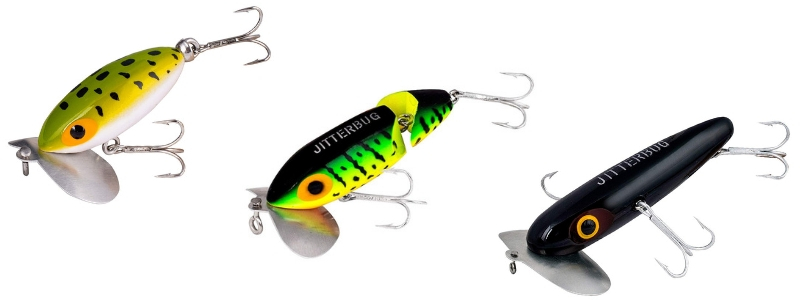
Since the Jitterbug’s birth in the 1930’s, many other topwater lures have come and gone, and the Jitterbug still remains a useful tool for bass fishermen. Some modern anglers overlook this timeless classic, but make no mistake, Jitterbugs are still great topwater baits.
Jitterbugs have a double-cupped lip attached at the front of the lure. The lip causes the bait to shift from side to side at it’s retrieved. This motion creates an attractive commotion on the surface that attracts attention. Once it gets the attention of a bass, the visual presentation imitates a really easy meal.
The basic design and function of the Jitterbug has not changed much over the years. Instead, the few alterations that the lure has received have mostly been limited to materials, sizes, and colors.
Types of Jitterbugs
Introduced as a wooden lure with a metal lip, the Jitterbug was forced to make a few changes after World War II broke out and forced a shortage in metal. At that point, Arbogast changed direction and started making a version of the Jitterbug where both the body and the lip were crafted from plastic.
Once the war ended, Arbogast was able to reinstate the metal lip, but the plastic body remained. These early plastics did not stand the test of time, so finding one of the vintage plastic models is rare.
Now all Jitterbugs are made of a durable, long lasting plastic. But over the years as plastics evolved, so too did the Jitterbug family, introducing new sizes, styles, and designs.
Classic Jitterbug
This is the classic Jitterbug design, based on the original wooden model from the 1930’s. It’s made up of a single oval-shaped piece of hollowed plastic and equipped with two treble hooks.
Jointed Jitterbug
These Jitterbugs are made up of two pieces that are connected by a hinge that allows the tail end of the bait to have a swinging motion as it’s retrieved. This adds extra action to the bait while giving it a larger profile.
XL Jitterbug
At four and half inches long, this is the largest Jitterbug model. It features two sets on treble hooks on the front and one in the back. This bait is mainly used for targeting pike and musky, but it’s also a great lure for big bass.
Weedless Jitterbug
Instead of two swinging treble hooks, these jitter bugs have two hooks that face upright. This allows the bait to ride up and over surface vegetation like lily pads. There aren’t many weedless topwater options out there so this is a pretty special bait.
Jitterbug Clicker Option
One thing to note before choosing a Jitterbug is that some come with a “clicker” built in. This is just a metal ball that is inside the hollow body of the bait that shifts from side to side as the bait wobbles. It creates a “clicking” sound that just gives the bait some additional noise.
Jitterbug clickers are helpful when there is some chop on the surface and the extra noise may be helpful. On calmers waters the clicker might be too much noise, and the standard model would be better.
Jitterbug Fishing
The textbook way to fish a Jitterbug is to simply cast it out and reel it in a slow and steady retrieve. There is only a small range of speeds you can reel it because if you reel it too fast or too slow you won’t engage the wobbling action.
But there are some tactics you can implement when the regular retrieve isn’t getting results.
Let It Sit
The first one to try is letting the bait sit in place when it hits the water. The rule of thumb is to wait until the ripples disappear.
This is usually the perfect amount of time for this technique to work. Bass will either hit it after a few seconds of it sitting there, or the second it starts moving.
Stop and Go
Another good tactic is using a stop-and-go retrieve. Cast the Jitterbug out and let it rest a bit, then reel it in for about ten feet, then stop and let it rest again.
After a few seconds, reel it in another ten feet or so. Continue this all the way in. Sometimes this will produce strikes when nothing else works.
Night Bite
Jitterbugs might be best known for their nighttime productivity. This is a reputation most topwater lures have, but the Jitterbug especially. They make a great sound and you don’t need to see them to know they’re performing.
Besides the weedless one mentioned above, Jitterbugs are not weedless. In fact they are quite the opposite. The two treble hooks grab anything and everything in their path, so you’ll will want to stay clear of any weeds. Especially at night when it will be tougher to see them.
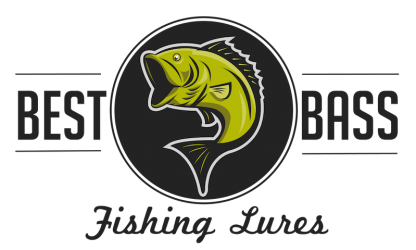
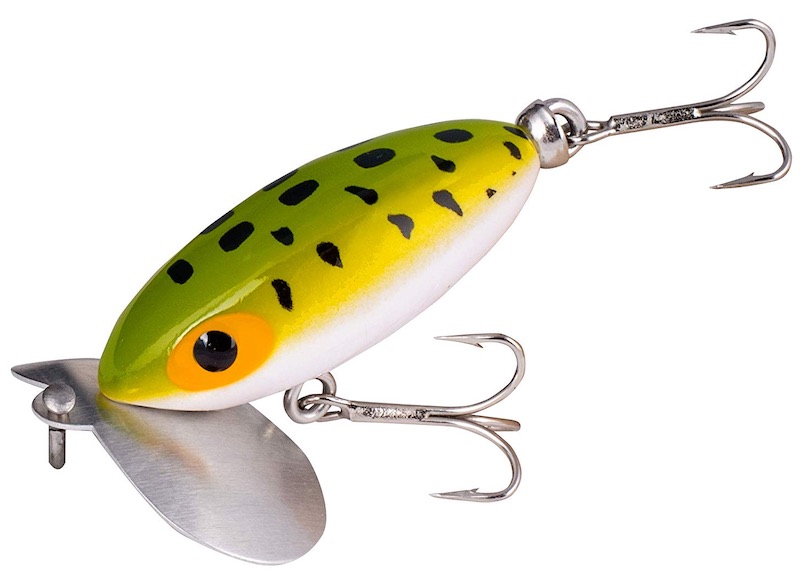

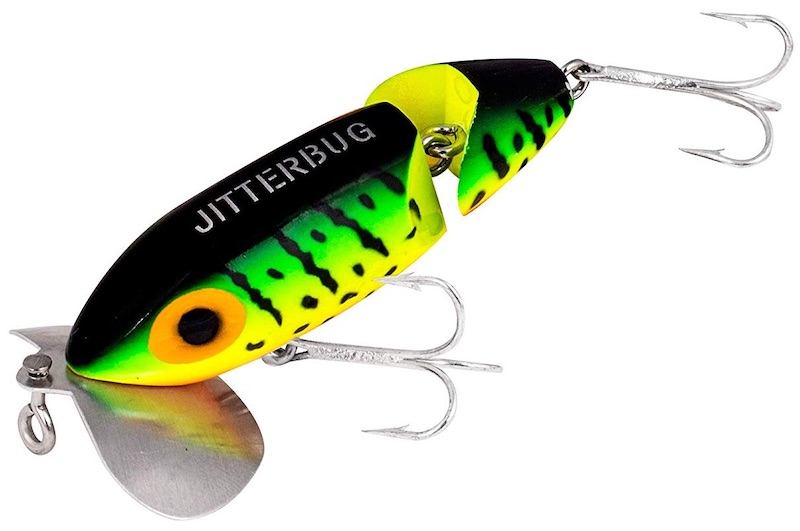
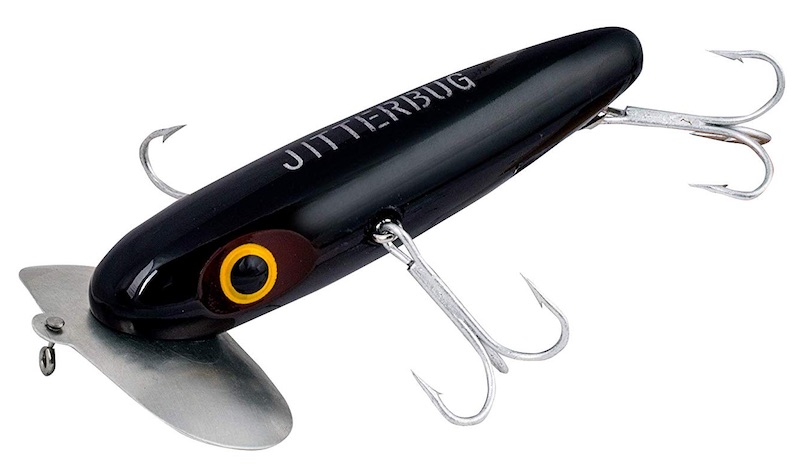
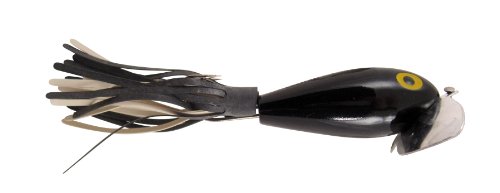

Ken says:
Greatest bass lure ever !!
Tommy Kircher says:
Spring, 4 to 6 ft. water, bass watching over beds, still water, sun rising, winds calm, low clouds, black Jitterbug or black Hula Popper….paka paka paks, or plop wait…plop wait/steady slow pull of Hula Popper…tough, tough call which has produced my best bass fishing moments. I could argue the points of each in the mirror 🙂
Aaron says:
Caught my pb largemouth (7.5 lbs) on a classic jitterbug like the green one at the top when I was 16 in a farm pond. Had just switched from the classic hoolah-popper. Still one of my go to’s at dawn and dusk. Still produces small to medium large and small mouth.
maury gardner says:
my great uncle show me how to use a jitterbug when i was very young and been using them for than 35 years they are my go to lure when nothing else works
Bill Geans says:
I have a jitterbug with a plastic lip when were they produced?
Chuck Northcutt says:
My go to late day bass lure. Have used them since the late fifties and black is my favorite color.
Great bait for bedding fish.
Hang on!!!